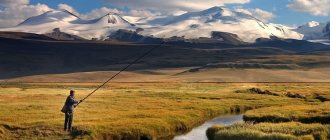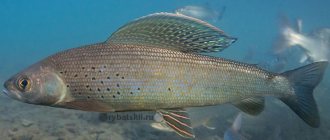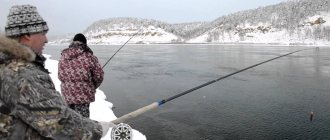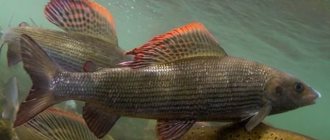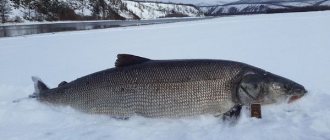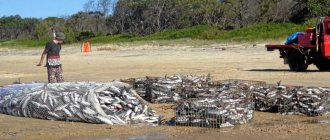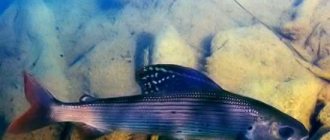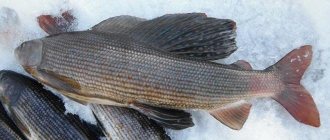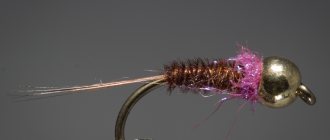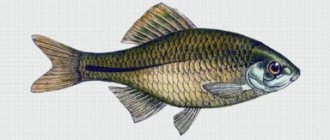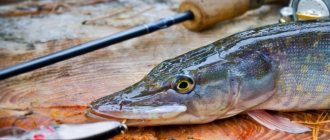Grayling has long attracted the attention of fishermen. These colorful fish are not easy to catch, making fishing fun and interesting. In addition, the meat of this river inhabitant is tender, healthy and very tasty.
The grayling fish takes its history from the salmon family. This is a predatory inhabitant of freshwater bodies. Its appearance makes it easy to recognize it among other representatives of river fauna.
Features:
- a significant and colorful fan-shaped fin on the back;
- big eyes;
- small mouth with teeth on top of jaw;
- dense scales;
- there is an adipose fin, indicating belonging to a noble family;
- peculiar color.
There are characteristic spots on the top of the body. The fin on the back is also decorated with a scattering of spots. The fin on the back can be used to distinguish a male from a female. The female Grayling has a higher fin towards the tail, while the male, on the contrary, has a lower end or is even even along the entire length. The dorsal fin has a red-bluish tint, which further helps to distinguish it from other fish. The color of the scales is represented by stripes and inclusions of both bright colors and almost black ones. Dark shades predominate on the back and sides (dark blue, silver). Grayling has a light-colored belly: white, gray or yellowish. In young fish, the transition between light and dark parts of the body is not so clearly expressed; you can notice a large number of dark stripes.
The salmon origin of Grayling is indicated by the adipose fin, which is located between the dorsal and caudal fins.
The habitat has a significant influence on the color: in a clear mountain river the fish will be lighter in color, in muddy water it will be a steel shade. Variegated, varied colors help individuals in the struggle for survival.
Fish of this species are small in size. The average body length is about 40 cm. Weight is in the range of 1 – 3 kg, differs by subspecies and habitat. For example, in the Urals you can catch grayling weighing 2.5 kg. These representatives of the ichthyofauna are very active fish, they can grab prey on the fly, jumping out of the water. The life cycle is approximately 14 years, from the age of three the fish is ready to spawn (sexual maturity varies by subspecies).
Types of grayling
The three most common types of grayling are Siberian, European and Mongolian.
Siberian grayling
Siberian grayling mainly lives in the east and northern part of Siberia, in the south it chooses cold rivers and lakes.
Contains subspecies:
- East Siberian;
- West Siberian;
- Alaskan;
- Kamchatka
The appearance of the Siberian grayling is characterized by a difference - it has a wider, but shorter dorsal fin. The spots on the body are large, with a metallic sheen. Representatives of the East Siberian subgroup have a number of dark red stripes with a characteristic elevation on the back. The growth rate of fish depends on the depth of reservoirs and the sufficiency of food. For example, grayling in the polar regions grows slowly, reaching only 500 g by the age of 10. And in Kolyma, the weight of adult fish reaches up to 200 g.
The breeding season for Siberian grayling begins during the flood period (late spring/early summer). To do this, he chooses a place with a weaker current, and in lakes - sections of the shore with flowing streams.
European grayling
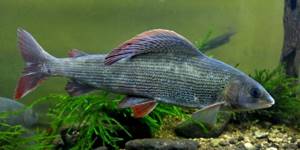
The distribution area is very wide: from Great Britain to the Urals. It has a bright body with spots. On both sides of the body there are longitudinal stripes of brown color. Additional fins are reddish or gray-yellow.
European grayling has a large mouth. Lives in the basins of the Baltic and White seas, Volga and Dniester. Selects rivers with rapid currents and a poor choice of food. Because of this, the growth of such grayling is long. Living conditions and diet can contribute to achieving 500 g or just two hundred in the same period of life. An adult grayling of this subspecies can reach 50 cm in length and weigh up to 6.5 kg.
During spawning, the color of European grayling becomes brighter. Females are smaller in size than males and are able to lay eggs from the age of two.
Mongolian grayling

Individuals of this subspecies can be found in reservoirs in the north-west of Mongolia and the Republic of Tuva. Mongolian grayling is the largest of all species: length up to 65 cm, weight up to 6 kg. The Mongolian grayling is characterized by an elongated head and a very large mouth with developed teeth. The color of the back and sides is dark gray, the belly is light. The fin on the back is gray with a dark red border. The remaining fins are pale pink.
It begins to spawn at the age of 5-6 years. It spawns in the second half of spring in rivers and their tributaries on the shallows.
European grayling
European grayling
— Thymallus thymallus Linnaeus, 1758
Population:
Populations of the river basins of the upper Volga and Ural
Rarity category:
2 – declining populations of a widespread species.
Spreading:
The species' range covers Europe from France and England to the west. up to rr. Kara and Ural to the east. and from r. Danube in the south to the Barents Sea in the north. Bass inhabits Russia. rivers flowing into the Baltic, Barents, White and Kara seas, bass. the upper and middle Volga (including the Kama basin) and the basin. R. Ural [1]. In the bass. Oki disappeared. In the bass. R. The Urals are currently preserved only on the territory of Russia [2] in several right-bank tributaries of the river. Ural (basin rivers Bolshoi Yushatyr, Bolshoi Ik and Sakmara) [3,4]. In the bass. the upper Volga is found in Tver, Moscow, Yaroslavl, Kostroma, Vologda and, possibly, Ivanovo regions. (disappeared in the Nizhny Novgorod region) [5,6]; in the bass R. The Urals are in the Republic of Bashkortostan, Orenburg and, possibly, Chelyabinsk regions.
Habitat:
Prefers bodies of water with clean and cold water; more often found in rivers and streams, less often in lakes. There are river, stream and lake ecotypes of grayling [7,8]; Currently, mainly the stream ecotype has been preserved, which more easily adapts to anthropogenic impacts than others and is represented by a number of small populations isolated from each other [4,9,10]. It differs from the river and lake ecotypes in earlier sexual maturation (at the age of 1+-2+), small size (length does not exceed 24 cm, weight 150 g), low absolute fecundity (does not exceed 2 thousand eggs) [8-10] , the diet is dominated by insects falling into the water; in the river and lake ecotypes, adult individuals have a length of 30-50 cm, a weight of 0.5-1.0 kg, and absolute fecundity reaches 36 thousand eggs. River populations exhibit pronounced homing [11]. All ecotypes spawn in May at currents and shallow depths. Eggs are deposited on hard ground.
Number:
Decline in the number of populations of European grayling in the basin. Volga was noted back in the 19th century. [9,12]; before that, it disappeared in the middle reaches of the Oka River [13]. In the bass. R. The Ural also lived in the left-bank tributaries in the past, where it is absent now [4]. The reduction and disappearance of individual populations primarily affects the large form (river and lake ecotypes). The small form (stream ecotype), due to its small size (not so attractive for fishermen) and short-cycle nature (the rate of reproduction increases), more successfully resists anthropogenic impact and therefore persists in a number of places [9,14]. Apparently, only the stream ecotype is able to withstand intense anthropogenic impact, which contributes to the formation of short-cycle populations consisting of small individuals; this allows the species to survive, but its gene pool is apparently depleted [8,9]. The stream ecotype is represented by isolated, small populations living in streams, rivers and upper reaches of rivers. The size of individual populations, apparently, does not exceed several thousand producers. The main limiting factors are intensive fishing by the local population [4,5,10,12], pollution of rivers and streams by various runoff [4,14].
Security:
It is necessary to conduct an inventory of surviving populations and assess their current state, carry out cryopreservation of genomes, and organize specially protected natural areas in the habitats of endangered populations, in particular in bass. R. Katraly (Orenburg region) and in the basin. R. Lutosni (Moscow region) [4,10].
Source:
1. Berg, 1948; 2. Fishes of Kazakhstan, 1986; 3. Red Book of the Bashkir Autonomous Soviet Socialist Republic, 1987; 4. Red Book of the Orenburg Region, 1998; 5. Puzanov et al., 1955; 6. Kuznetsov et al., 1974; 7. Korotaeva, Zinoviev, 1992; 8. Zinoviev, 1992; 9. Zinoviev, 1985; 10. Zinoviev
Compiled by:
N.I. Shilin.
AOF | 27.11.2014 15:21:52
cicon.ru
Grayling habitats
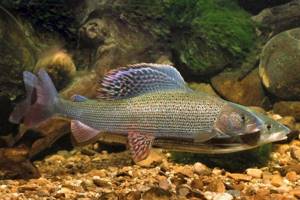
Grayling is found in clean, fresh water with a high oxygen content. It can exist in reservoirs at an altitude of up to 2.4 km, in rivers of the plains, but the main habitats are mountain rivers and large streams. Less often, graylings choose lakes for their residence. Can live in brackish water.
Features of grayling habitats:
- rivers with an uneven bottom made of stones and pebbles, the bed of which is winding;
- prefers rifts and rapids with cool water;
- in winter it hides in deep pools and holes;
- sticks to the shore in small rivers and streams;
- in deep rivers, chooses places away from the shore (swims up to feed in the morning and evening);
- There must be a patch of clean water near the main habitat where he will hunt;
- chooses a place to live nearby with shelter (snags, tree trunks and branches that have fallen into a pond, river bottom vegetation).
In summer, grayling chooses places with calmer currents. There are deep holes and uneven spots in front of river riffles, which is where grayling prefer to hide.
Graylings like to stay alone, so they avoid competition when catching food with their relatives. But there are exceptions, for example, when the river lacks good riffles, holes and flats, then grayling stay in a group of about 7-10 fish.
Population and species status
Since the 19th century, there has been a decline in the populations of large species of Siberian grayling in the basins of the Oka, Volga and other rivers. Small, “stream” species quickly restore their numbers because they spawn more often and are not so attractive for fishing. There is no serious threat to the extinction of grayling.
However, in a number of habitats, an important factor can be anthropogenic - pollution of the purity of water, to which this fish is very demanding, or overly intensive fishing. European grayling is listed as protected according to the Berne Convention, and is also included in the Red Books of Russia, Belarus, Ukraine, Estonia, Germany and other countries.
Return to content
Grayling lifestyle
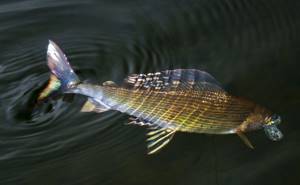
This fish is vigilant and attentive, it sees, hears and feels perfectly. Grayling leads an isolated and sedentary lifestyle and does not leave its habitat for more than 20 km. Grayling forms schools only before the start of spawning. The inhabitants of fast rivers go to their sources with the onset of spring, and return with the onset of cold weather. The inhabitants of the lakes spawn in their usual habitats.
Their lifestyle and behavior are determined by the fact that grayling is a predator. He notices what is happening on the shore and on the water: suspecting danger, he immediately goes into hiding. The main hunting time is morning; during the day it consumes insects caught in the water. At lunchtime it hides in the depths. Sometimes fish jump out of the water and flip over in the air. This is how fish train their bodies, because life in fast-flowing rivers requires strength and energy.
The diet of grayling consists of: river microorganisms, algae, fry and eggs of other inhabitants. In the warm season - worms, dragonflies, mosquitoes, horseflies, flies, midges.
Graylings make two seasonal migrations during the year. In the spring, when the flood passes, they rise along the sources of the river against the current, there they spawn and build up fat. Grayling, which live in lakes, move along the shore in the spring in search of tributaries where they spawn. The largest and loneliest individuals prefer to climb further upstream than others in search of a more favorable place for breeding.
In autumn, with the onset of cold weather, graylings descend the river, where they spend the winter in pits. During the cold period, they continue to feed, but move little. During these immigrations, Graylings do not travel long distances.
Spawning periods are determined by the subspecies of fish and the climate in the habitat; as a rule, the water temperature should reach 5-10°C. In Grayling, the ability to reproduce is achieved by 2 years, and in males by 3 years. During the breeding season, males change their color to a brighter one, and the fin enlarges. Spawning begins with warming and selects shallow areas of the river. At the spawning site there should not be a strong current and the bottom should consist of pebbles or sand. Before laying eggs, Grayling builds a nest in the form of a small hole and after 16-20 days the fry appear.
European grayling - Fishes of the Pskov region
Signs:
The body is oblong, moderately elongated, the head is small with a sharp snout, the mouth is upper. The scales are small. The upper fin is large, colorful and bright with patterns of spots or stripes. The shape and color of the dorsal fin in fish of different populations have noticeable differences. There is an adipose fin between the dorsal and caudal fin. The upper jaw protrudes forward. The maxillary bone is short and does not extend beyond the anterior edge of the eye. There are 19 - 30 gill rakers, on average about 24 - 26. The teeth on the jaws, vomer, and palatine bones are poorly developed. The dorsal fin has 4 - 10 hard rays and 11 - 17 soft rays (19 - 24 in total), the anal fin has 3 - 4 hard rays and 8 - 11 soft rays. The pectoral fins usually have 1 hard ray and 12–17 soft fins; the ventral fins have 2 hard rays and 8–12 soft rays. The caudal fin has 19 - 21 rays. D IV-X 11-17 (total 19-24), A III-IV 8-11, P I 12-17, V II 8-12. In the lateral line there are 72 - 98 scales, pyloric appendages 12 - 37, vertebrae 56 - 62. Karyotype: 2n = more often than 102, with fluctuations 100 - 108, NF = 160 - 170. There are no subspecies.
The color is greenish or bluish-silver, the back is dark with black spots, and there are brownish longitudinal stripes on the sides. The dorsal fin is colorful and bright and has several parallel rows of dark spots, the pectoral and ventral fins are red or yellow, the anal and caudal fins are purple. During the spawning period, the color is brighter; an orange-red border appears on the dorsal fin. Juveniles have dark transverse spots (parr-mark).
Length: average up to 30 - 40 cm, max length up to 60 cm.
Normal weight is 0.2 - 1.3 kg. Individual individuals reach a weight of 2.5 - 3.0 kg, the maximum recorded weight is 6.7 kg (1956, Lake Konnevesi, Finland). Maximum life expectancy is 14 years.
Area
Widely distributed throughout Europe from Great Britain and France in the west to the Ural Mountains in Russia in the east and from the Danube River in the south to the Barents Sea in the north. In Russia, it is found over a large area in river basins flowing into the Baltic, Barents and White Seas, the basins of the upper and middle Volga and in the upper reaches of the river. Ural. Widely distributed in Karelia, Murmansk and Leningrad regions. Available in lakes Ladoga and Onega. Absent in Ilmen and Pskov-Chudskoye Lake, although it is found in the basin of these reservoirs. In the Pskov region, grayling, in some respects, differs sharply from the typical forms of the species and represents a special geographical population. Found in tributaries of the Plyussa River (not recorded directly in the Plyussa River), the Belka, Volostnya, Chernaya, Lochkina, Pizhma, Kureya, Lyuta, Sitnya, Kudeb, Alol rivers (including the Velikaya River near the mouth of the Alol River ). Previously, it was found sporadically in the Rushchera River (the Western Dvina basin), but after 1990 it was not found in catches. Currently, due to river pollution, deteriorating breeding conditions and increased fishing, the number of grayling continues to decrease.
Lifestyle
Lives in clean, cold-water rivers and lakes well saturated with oxygen, preferring reservoirs with pebble and rocky bottoms and with a moderate current of 0.2 - 0.5
m/sec
. Can form small flocks. Very sensitive to pollution, the optimal living temperature is 6 - 18 ° C and water pH 7.0 - 7.5. More often found in rivers and streams, less often in lakes. It can form river, stream, lake-river and purely lacustrine ecotypes. At present, mainly the stream ecotype has been preserved, which adapts more easily to anthropogenic impacts than others and is represented by a number of small populations isolated from each other. It differs from the river and lake ecotypes in earlier puberty (at the age of 1+ - 2+), small size (length does not exceed 24 cm, weight 150 g), low absolute fecundity (does not exceed 2 thousand eggs), in the river and lake ecotypes ecotypes, adult individuals have a length of 30 - 50 cm, a weight of 0.5 - 1.0 kg, absolute fertility reaches 36 thousand eggs.
Reproduction: Puberty occurs in males at the 2-3rd year of life, in females at the 4th year of life. Spawning takes place in April - June at water temperatures of 4 - 8 °C. Spawning grounds are located in shallow pebble areas of fast-flowing rivers. Average fecundity is 1 - 36 thousand eggs (average 3 - 10 thousand eggs). Caviar with a diameter of 3 - 4 mm, light yellow in color. Hatching of the larvae occurs 3 - 4 weeks after spawning. Females build shallow nests on clean pebble shallows (usually 20 - 40 cm deep) with a moderate current (about 0.5 m/sec
), where they lay eggs. After hatching, the larvae almost immediately leave the spawning nests. It grows quickly, reaching 10 - 15 cm at one year of age.
Diet: Predatory omnivorous fish, feeds all year round. Hunts in open areas of the river or in lakes, at the confluence of rivers. It feeds mainly on small crustaceans, mollusks, worms, aquatic and flying insects and their larvae, and fish eggs. Large individuals can eat small fish.
Security status
Decline in the number of populations of European grayling in the river basin. The Volga was noted back in the 19th century; before that it disappeared in the middle reaches of the river. Okie. The reduction and disappearance of individual populations primarily affects the large form (river and lake ecotypes). The small form (stream ecotype), due to its small size (not so attractive to fishermen) and short-cycle nature (higher rate of reproduction), more successfully resists anthropogenic impact and therefore persists in a number of places. The stream ecotype is represented by isolated, small populations living in streams, rivers and upper reaches of rivers. The size of individual populations, apparently, does not exceed several thousand producers. There are no known serious or widespread threats, but at the regional level the main limiting factors are intensive fishing by the local population, pollution of rivers and streams by various runoff, and littering of watercourses, including spawning grounds. The southern part of the range is more vulnerable to climate change. Locally it may be subject to pressure from birds of prey.
European grayling is subject to protection in Europe, as listed in List III of the Annex of the Berne Convention.
IUCN Red List Status: Least Concern (LC) as a widespread species with no known major threats.
The species is listed in the Red Book of Russia (category 2 - declining populations of a widespread species), and is listed in the Red Books of the Republic of Belarus, Ukraine, Germany and Estonia.
The species is listed in the Red Books of the Yaroslavl, Orenburg, and Moscow regions, and is listed in the Red Book of the Pskov region (category 3 - a rare and vulnerable species in the rivers of the Pskov region, sporadically distributed).
Security measures.
According to the fishing rules for the Western Fishery Basin, fishing is prohibited throughout the entire territory of the Pskov region. The primary measures to protect and increase numbers are to prevent habitat destruction and restore the properties of river biotopes. Organization of artificial reproduction of grayling.
pskovfish.ru
Lures for grayling
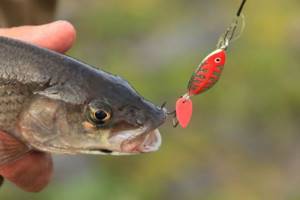
When going fishing for grayling, it is important to consider that they are predators. Therefore, you need to choose a bait that is accessible and attractive to him. Also, this fish is shy, and fishing conditions with intense currents create certain obstacles.
Lures can be divided into:
- natural;
- artificial.
From the first group of baits for fishing on the surface, grasshoppers, flies, beetles, dragonflies and horseflies have proven themselves to be excellent. To catch fish in the vast depths, larvae, bloodworms, worms, and maggots are useful. It is good to use minnows (small fish from the carp family).
Among the artificial baits for grayling, the following stand out:
- Rotating spinners (spinners).
With the help of a spinner, the attention of grayling is attracted, and fish are caught using attached natural bait. According to experienced fishermen, even after eating the bait, fishing can be continued with one spoon. For more successful fishing, it is better to use a spoon with dark dots. For fish, they imitate midges or spiders. Popular are large spinners, which are more noticeable in the water. - Wobblers.
Their main advantage is their ability to withstand strong currents; they successfully sink and do not rise to the surface of the water. There is a wide variety of wobblers, which makes it possible to change bait more often in order to catch grayling. Swinging smoothly in the water, they look like a sick fish, thereby attracting grayling. The most suitable bait parameters are 4.5 cm, weighing up to 5 g. Artificial baits can be used repeatedly.
For summer fishing, you can use a variety of natural baits, baits and fishing methods. You need to prepare for winter fishing in advance or purchase bait in special stores.
An amazing feature of grayling is its love for cottage cheese. A fish may also peck at a grain of foam plastic, mistaking it for cottage cheese. In the fall, fish descend to the bottom in search of food, so they will not be attracted to bait on the surface. Long casts will be more effective in this case. In the spring, the fish are busy spawning and are easy to catch.
{banner_vnutri-kontenta-3}
Ways to catch grayling
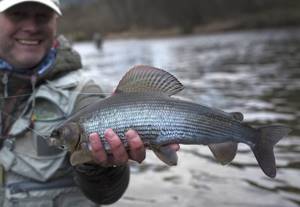
Equipment, clothing and behavior of the fisherman influence the results of fishing. You should not wear bright clothes, make sudden movements or make noise. Methods are determined based on the season, personal skills, and terrain characteristics.
The basic methods for catching grayling are as follows:
- On a fishing rod with a float.
A suitable option for fishing in small rivers or lakes. You need to hold the fishing rod so that the continuous movement of the float attracts fish. Live baits work well: flies, butterflies. The optimal length of the tackle is 5 m, the size of the fishing line is in the range of 0.15-0.30 mm. A thin hook is not the best option, since the lips of grayling are thin and can be easily damaged. - Using spinning.
This method is also suitable for small bodies of water. The optimal length is up to 3 m, the fishing line size is 0.10-0.15 mm. For bait, use spinners and wobblers. The spinning rod must be kept above the surface of the water and regularly lowered, thereby luring grayling. Artificial baits are suitable. - To the donk.
Grayling bites better on it in the winter season. Artificial baits are used for fishing. - Fly fishing.
Among fishermen, this technique is considered the most successful. The rod should be light, 2 - 5 m long. The cord is selected based on the type of fly. For dry use a floating cord, for wet use a sinking cord. The choice of fly is based on the characteristics of the grayling feeding area. Leash 0.2 mm thick. Any bait is suitable, you should take into account the natural conditions and size of the reservoirs. - With the help of a boat.
The method is used when there is intense flow and when catching predatory fish. The gear includes the boat itself, the fishing line on which leashes with bait are attached, and a reel for winding the fishing line.
To catch grayling on frozen reservoirs, use the usual winter accessories: fishing rods with a nod and a jig. To increase efficiency, a worm or a piece of fish is threaded onto the hook. With this method, it is also necessary to create bait activity in order to arouse the hunting interest of grayling.
Gastronomic value of grayling
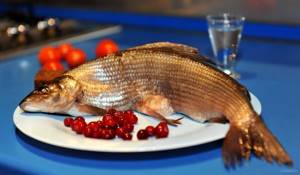
Grayling is not only interesting in appearance, but also very pleasant in taste. The fillet is juicy and the number of bones is small. The fish does not become loose after heat treatment. Compared to other river inhabitants, grayling has no specific odor and is very gentle. Meat with moderate fat content and cucumber flavor.
The product is easily and completely absorbed by the body. The substances contained in it strengthen the immune system, support the health of the digestive and nervous systems, and help restore strength.
Due to its properties, grayling has gastronomic value for dietary nutrition, replacing meat. You can prepare a huge number of dishes from it: boil soup, fry, bake, steam, salt and smoke. The soup turns out very tasty, with a clear broth and incredible aroma. The main thing is not to overheat the fish unnecessarily, so that the meat does not become overdried and hard.
Despite all the usefulness of grayling, it is important to understand that salted or fried fish is considered a high-calorie product.
In the summer, immediately after fishing, the fish is processed, sprinkled with salt, and then covered with grass for storage. Smoked grayling has a wonderful taste.
Meat is rich in calcium, iron, fluorine, zinc, chromium, contains saturated and unsaturated fatty acids, and PP vitamins.
Not a single grayling treat will leave connoisseurs of fish dishes indifferent.
Calorie content of grayling
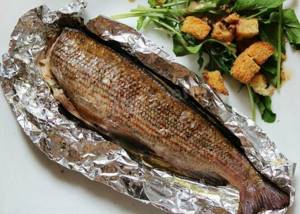
The calorie content of grayling is low: 88 kcal per 100 grams of fish. This allows people who are watching their figure and diet to consume fish. The absence of carbohydrates, the predominant composition of protein (17.5 g), and a small amount of fat (2 g) makes the fish attractive to the consumer.
Calorie content of grayling caviar: 200 Kcal per 100 grams, 28.4 g protein, 9.3 g fat, 0.6 g carbohydrates.
The calorie content of grayling that is processed (fried, smoked or salted) higher than boiled or steamed can reach 140 Kcal.
European grayling
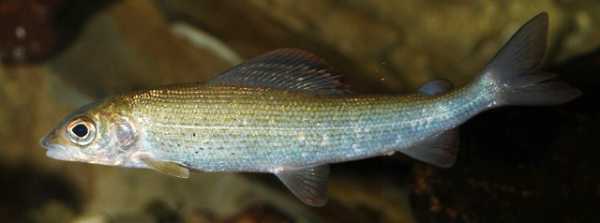
Taxonomy
- Latin name: Thymallus thymallus.
- Order → Family → Genus: Salmonidae → Salmonidae → Grayling.
- Closely related species: Siberian grayling.
general information
- Description: river fish, lives in small and medium-sized rivers with cold, oxygen-rich water. In the Middle Urals it forms two forms - river and stream. The first is a larger one, preferring high-water rivers, and can make seasonal migrations between the tributary and the main river. The second form prefers to live in small rivers and streams; it differs from the first by being more sedentary, early maturing and slow growing. The stream form is also more numerous.
- Schooling: can stay alone (mostly typical for large individuals), or unite in small groups (on average 10-20 fish).
- Dimensions, weight: usually there are individuals 20-30 cm long and weighing 100-300 g. In some rivers it can reach a weight of 1 kg or more.
- Seasonal activity: active all year round.
- Migrations: the semi-anadromous form enters small tributaries and upper reaches to spawn. In the winter it can migrate to deeper places. The rest of the time he leads a relatively sedentary lifestyle.
Nutrition
- Personality: predator.
- Objects: aquatic or semi-aquatic invertebrates, insects, juvenile fish. Large graylings can feed on small mammals such as mice or shrews.
- Seasonal preferences: no particular ones, feeds on aquatic invertebrates all year round. In summer, insects falling into the water are added to them. During the hours of mass emergence of a certain type of insect, it can switch to feeding exclusively on them, while ignoring other food.
- Places for feeding: on large rivers - rifts, rapids. In small rivers it usually stands in quiet places behind natural obstacles, jumping out for food passing by.
Spawning
- Age of sexual maturity: females - 2 years, males - 3-4 years.
- Required water temperature: 8-10 °C.
- Places: pebble and rocky shallows with current.
- Period (for the Middle Urals): mid and second half of May.
Catching
- Turbid water: donka (worm, bloodworm, maggot).
- Light water: spinning rod (spinners, mini-wobblers), float rod (insects, worms, bloodworms, maggots), surface tackle (artificial flies, insects), donka (worms, bloodworms, maggots).
- Freeze-up: jig (bloodworm, maggot, jig, bark beetle), no-bait, winter spinners.
- Difficulty: the smaller the river, the more attention needs to be paid to camouflage.
- Fighting: actively resists.
Habitat reservoirs
In the Middle Urals it is found in the rivers of the Kama basin (Chusovaya, Ufa, Sylva), and in most of their tributaries.
The nutritional value
- Meat: has excellent taste.
- Protein content: 17.5%.
- Fat content: 2%.
- Calorie content (per 1 kg): 880 kcal.
If the article was useful, you can
urochishe.ru
